Faster servicing through smarter access
Introduction
Maintaining the core mechanical and hydraulic systems of a street sweeper—the engine, hydraulics, suction system, and pickup-head linkages—is critical for ensuring reliable operation, sustained sweeping performance, and controlled operating costs. Without regular maintenance, minor issues can quickly escalate into major failures, leading to costly repairs, increased fuel consumption, excessive wear on moving parts, and unplanned downtime.
However, when daily maintenance is difficult, time-consuming, or ergonomically challenging, it is often avoided. Preventive-maintenance programs succeed only when inspection points are obvious, accessible, and fast to complete. The farther a component is buried inside the machine, the more labor hours it takes to reach it, and the greater the risk that small, hidden issues will worsen unnoticed.
Quick, intuitive access to daily service points not only prevents downtime but also extends equipment life, lowers operating expenses, improves operator safety, and ensures that sweepers deliver full mechanical and suction performance over their entire service life.
Maintenance only works when it’s easy, fast, and built for the people who have to do it every day.
Inefficiencies in traditional maintenance layouts
1. Engine maintenance access
Most street sweepers still rely on either tilting the entire driver’s cab forward or reaching through small rear or side hatches to perform daily engine inspections. Routine engine servicing often requires lifting heavy panels, operating hydraulic tilt systems, or accessing confined engine bays that are difficult to work within.
Challenges:
Tilting the cab or working through tight panels is slow, physically demanding, and sometimes dangerous if not properly secured. In busy operations, technicians may rush or avoid inspections entirely, leading to missed early warning signs of engine trouble. Over time, neglected engine servicing can result in sudden failures, long-term performance degradation, increased fuel consumption, and reduced engine life.
Additionally, tilt-cab designs increase labor time per service visit, raise technician fatigue, and add operational complexity, all of which contribute to higher maintenance costs and extended downtime.
2. Hydraulic system access
Hydraulic valves, cartridge filters, and key hoses are typically mounted deep inside the sweeper body. Access usually requires removing covers, bending inside cramped spaces, or crawling under the machine to reach hydraulic components.
Challenges:
Poor accessibility discourages thorough daily inspections. As a result, hidden leaks, clogged filters, or fluid contamination often go unnoticed until system performance drops or complete hydraulic failure occurs. Minor leaks that could have been fixed cheaply escalate into major overhauls involving full pump or actuator replacements, leading to extended downtime and major operational costs.
3. Suction system (impeller) inspection
Challenges:
Limited access results in infrequent or incomplete inspections. Suction loss typically progresses gradually, forcing the engine and blower to work harder, increasing fuel consumption and accelerating engine wear long before sweeping performance visibly drops. By the time performance issues are obvious, significant damage has often occurred, leading to expensive impeller repairs or complete fan replacements.
4. Pickup-head linkage maintenance
Challenges:
Because linkage points are low, dirty, and inconvenient to reach, lubrication and wear inspections are often skipped. Without regular greasing, pivot pins and bushings wear unevenly, causing progressive slop and misalignment in the pickup head. Neglected linkage maintenance drives up downstream costs dramatically. Early lubrication takes minutes, but repairing a damaged pickup-head mechanism can sideline the machine for days and require major component replacement.
How SwiftServe reduces maintenance effort and delays
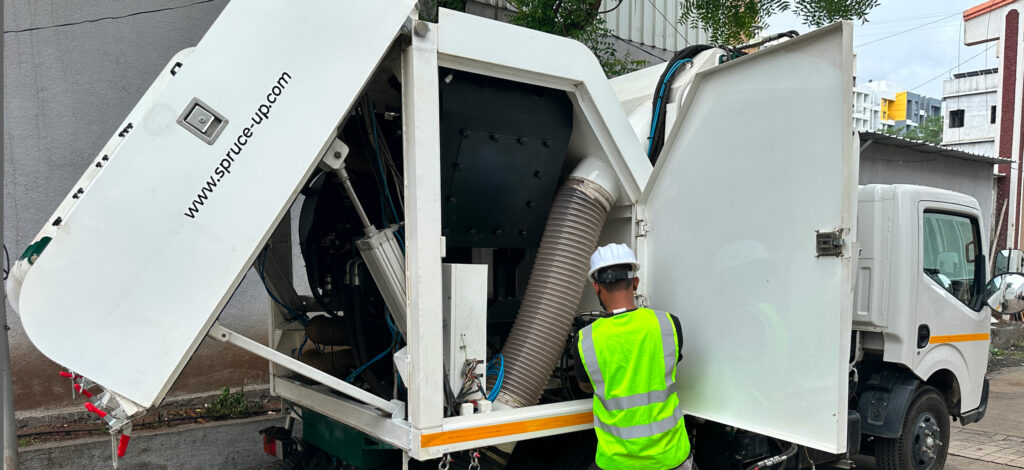
Stratus addresses these critical challenges through the SwiftServe rear architecture, fitted on the EVO 2 and EVO 4 sweepers.
1. Engine maintenance access
Technology
SwiftServe eliminates the need for cab tilting or confined hatch reaching by placing the engine access point directly within a centralized rear service bay. Wide gull-wing doors lift high overhead, and the engine is positioned so that routine inspection areas are reachable at belt height. This configuration allows technicians to perform engine servicing and inspections without lifting heavy panels, crawling under the machine, or using cab tilt mechanisms.
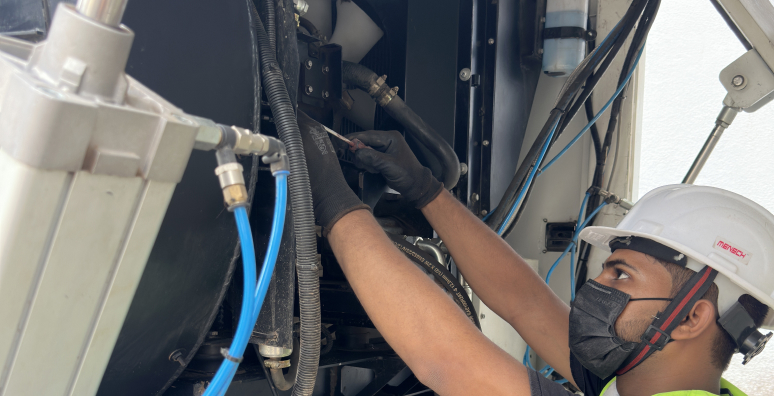
Benefits
By making engine access fast, simple, and ergonomically comfortable, SwiftServe reduces inspection time and technician fatigue. It encourages daily inspections, helping crews detect minor engine issues early and avoid sudden breakdowns. As a result, sweepers maintain better operational reliability, lower fuel consumption, and longer engine service life while minimizing workshop downtime.
2. Hydraulic system access
In the SwiftServe layout, hydraulic valves and the cartridge bank are clustered within the compact rear service bay, positioned for easy, standing-height access through the wide gull-wing doors. Slide-out trays assist technicians in reaching daily service checkpoints without needing to remove multiple covers or crawl under the machine.
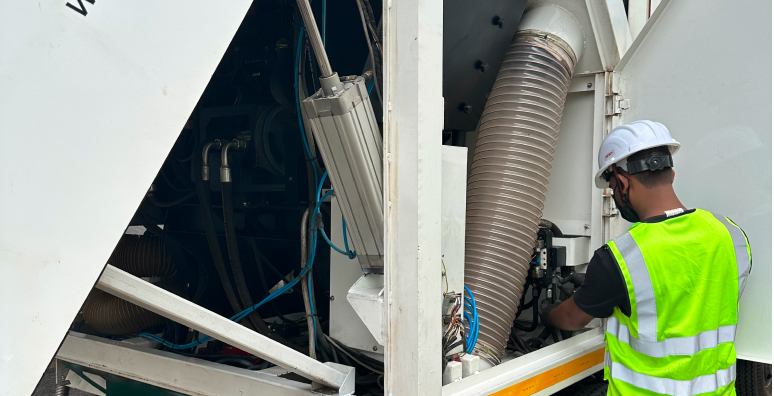
Benefits
By centralizing hydraulic servicing points and making them easily accessible, SwiftServe greatly simplifies and speeds up daily hydraulic system maintenance. This ensures that leaks, contamination, or early component wear are identified during inspections, reducing the risk of pump failures or actuator breakdowns. Keeping hydraulic systems clean and responsive helps preserve performance, lowers operating costs, and minimizes unexpected downtime.
3. Suction system (impeller) inspection
SwiftServe positions the impeller inspection hatch at standing height within the compact rear service bay, providing fast and ergonomic access for daily checks. Technicians can reach the inspection hatch without crawling or using special equipment, making it easier to perform routine suction system inspections as part of daily maintenance.
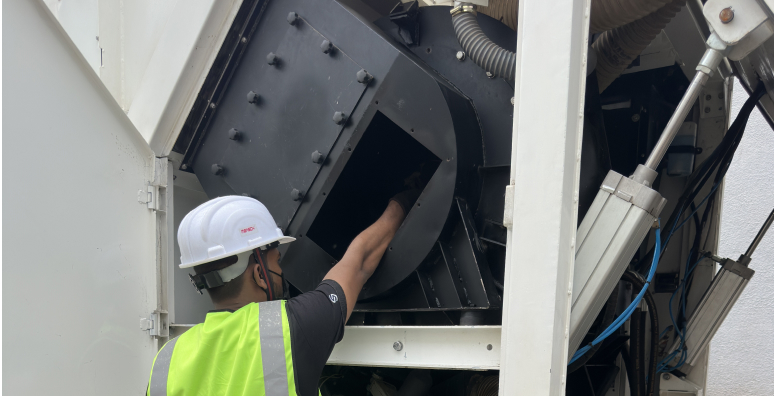
Benefits
By making impeller inspection more accessible, SwiftServe encourages more frequent maintenance checks, allowing crews to detect early signs of debris buildup, suction loss, or impeller housing wear. Maintaining a healthy suction system protects overall sweeping performance, reduces strain on the engine and blower, improves fuel economy, and minimizes the risk of expensive impeller repairs or replacements over time
4. Pickup-head linkage maintenance
Pickup-head linkage wear areas and grease points are clustered within the SwiftServe rear service bay, positioned for easy standing access through the wide gull-wing doors. Technicians can inspect and lubricate key linkage components without needing to crawl under the pickup assembly or work in difficult ground-level positions.
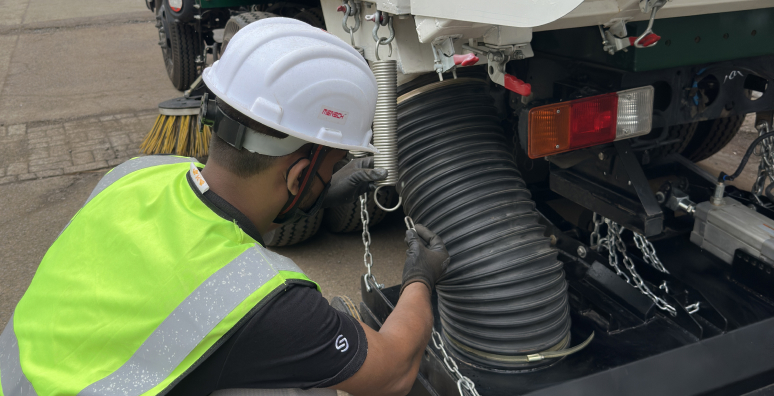
Benefits
By simplifying access to pickup-head linkages, SwiftServe encourages more consistent lubrication and inspection routines. Regular servicing prevents mechanical slop, pickup-head misalignment, and excessive wear. Well-maintained linkages help preserve sweeping quality, protect hydraulic actuators from unnecessary strain, and significantly reduce the risk of mechanical failures or expensive field repairs.
If your goal is to deliver consistently clean streets while controlling operating costs, SwiftServe isn’t just a convenience feature; it’s a practical advantage. Daily maintenance is the hidden variable that decides how much revenue a sweeper earns and how long it stays on the road. With SwiftServe Rear Architecture, Stratus EVO 2 and EVO 4 transform those invisible minutes in the yard into measurable gains on the street. The machines sweep more lane-kilometres per shift, spend fewer hours in the workshop, and hold their value longer.
